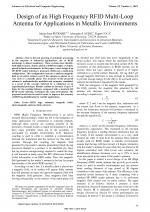| 2/2018 - 5 |
Design of an High Frequency RFID Multi-Loop Antenna for Applications in Metallic EnvironmentsPETRARIU, A. I. |
| View the paper record and citations in |
| Click to see author's profile in |
| Download PDF |
Author keywords
data engineering, knowledge representation, machine learning, social network services, social computing
References keywords
rfid(17), antenna(10), metal(8), metallic(7), environments(6), design(5), loop(4), frequency(4)
Blue keywords are present in both the references section and the paper title.
About this article
Date of Publication: 2018-05-31
Volume 18, Issue 2, Year 2018, On page(s): 35 - 40
ISSN: 1582-7445, e-ISSN: 1844-7600
Digital Object Identifier: 10.4316/AECE.2018.02005
Web of Science Accession Number: 000434245000005
SCOPUS ID: 85047855885
Abstract
Due to the fast growing of automatic processing in the majority of industrial applications, use of RFID technology is almost mandatory. These systems must identify, with high accuracy, objects placed at different angles or objects placed in harsh environments. In this paper, a new design of an HF RFID reader antenna is proposed, which uses a multi-loop configuration. This configuration ensures a uniform magnetic field on its entire surface, even if the antenna is placed on or very close to a metallic plane. The structure of the proposed antenna is mathematically modelled and computer simulated, as a proof of the concept, followed by a validation on an experimental prototype. Results confirm an increase of up to 9 times for the reading distance, compared with a standard HF RFID reader antenna, working in the same environment. The proposed model can be used in order to improve the accuracy of RFID tag identification in real life applications. |
| References | | | Cited By |
Web of Science® Times Cited: 5 [View]
View record in Web of Science® [View]
View Related Records® [View]
Updated today
SCOPUS® Times Cited: 4
View record in SCOPUS® [Free preview]
View citations in SCOPUS® [Free preview]
[1] On the design and implementation of efficient antennas for high frequency‐radio frequency identification read/write devices, Ofosu Addo, Ernest, Kommey, Benjamin, Selasi Agbemenu, Andrew, Kumbong, Hermann, Engineering Reports, ISSN 2577-8196, Issue 10, Volume 3, 2021.
Digital Object Identifier: 10.1002/eng2.12407 [CrossRef]
[2] Improving the Efficiency of NFC Systems Through Optimizing the Sintered Ferrite Sheet Thickness Selection, Victoria, Jorge, Suarez, Adrian, Martinez, Pedro A., Alcarria, Antonio, Gerfer, Alexander, Torres, Jose, IEEE Transactions on Electromagnetic Compatibility, ISSN 0018-9375, Issue 4, Volume 62, 2020.
Digital Object Identifier: 10.1109/TEMC.2020.3003800 [CrossRef]
[3] Near-Field Immunity Test Method for Fast Radiated Immunity Test Debugging of Automotive Electronics, Yousaf, Jawad, Lee, Doojin, Han, JunHee, Lee, Hosang, Faisal, Muhammad, Kim, Jeongeun, Nah, Wansoo, Electronics, ISSN 2079-9292, Issue 7, Volume 8, 2019.
Digital Object Identifier: 10.3390/electronics8070797 [CrossRef]
[4] Wearable near‐field communication bracelet based on highly conductive graphene‐assembled films, Li, Siting, Song, Rongguo, Zhang, Bohan, Huang, Bangqi, Zhao, Xin, He, Daping, International Journal of RF and Microwave Computer-Aided Engineering, ISSN 1096-4290, Issue 1, Volume 31, 2021.
Digital Object Identifier: 10.1002/mmce.22479 [CrossRef]
Disclaimer: All information displayed above was retrieved by using remote connections to respective databases. For the best user experience, we update all data by using background processes, and use caches in order to reduce the load on the servers we retrieve the information from. As we have no control on the availability of the database servers and sometimes the Internet connectivity may be affected, we do not guarantee the information is correct or complete. For the most accurate data, please always consult the database sites directly. Some external links require authentication or an institutional subscription.
Web of Science® is a registered trademark of Clarivate Analytics, Scopus® is a registered trademark of Elsevier B.V., other product names, company names, brand names, trademarks and logos are the property of their respective owners.
Faculty of Electrical Engineering and Computer Science
Stefan cel Mare University of Suceava, Romania
All rights reserved: Advances in Electrical and Computer Engineering is a registered trademark of the Stefan cel Mare University of Suceava. No part of this publication may be reproduced, stored in a retrieval system, photocopied, recorded or archived, without the written permission from the Editor. When authors submit their papers for publication, they agree that the copyright for their article be transferred to the Faculty of Electrical Engineering and Computer Science, Stefan cel Mare University of Suceava, Romania, if and only if the articles are accepted for publication. The copyright covers the exclusive rights to reproduce and distribute the article, including reprints and translations.
Permission for other use: The copyright owner's consent does not extend to copying for general distribution, for promotion, for creating new works, or for resale. Specific written permission must be obtained from the Editor for such copying. Direct linking to files hosted on this website is strictly prohibited.
Disclaimer: Whilst every effort is made by the publishers and editorial board to see that no inaccurate or misleading data, opinions or statements appear in this journal, they wish to make it clear that all information and opinions formulated in the articles, as well as linguistic accuracy, are the sole responsibility of the author.





